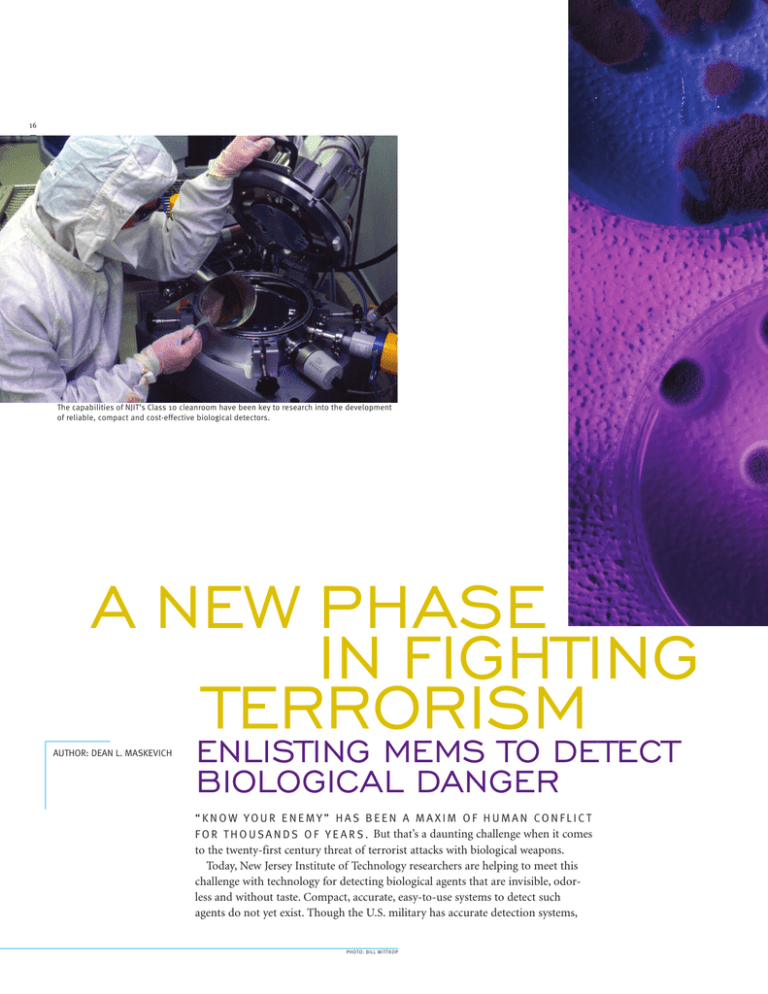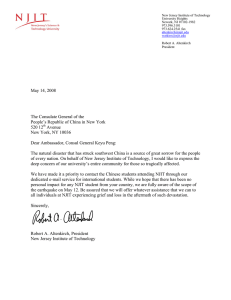Document 13213464
advertisement

16 The capabilities of NJIT’s Class 10 cleanroom have been key to research into the development of reliable, compact and cost-effective biological detectors. A NEW PHASE IN FIGHTING TERRORISM ENLISTING MEMS TO DETECT AUTHOR: DEAN L. MASKEVICH BIOLOGICAL DANGER “ K N OW YO U R E N E MY ” H A S B E E N A M A X I M O F H U M A N CO N F L I C T F O R T H O U S A N D S O F Y E A R S . But that’s a daunting challenge when it comes to the twenty-first century threat of terrorist attacks with biological weapons. Today, New Jersey Institute of Technology researchers are helping to meet this challenge with technology for detecting biological agents that are invisible, odorless and without taste. Compact, accurate, easy-to-use systems to detect such agents do not yet exist. Though the U.S. military has accurate detection systems, PHOTO: BILL WITTKOP 17 NJIT MAGAZINE they are slow, complicated to use, and expensive. They are also bulky — some are as big as SUVs. Current hand-held detectors available to military personnel and civilian authorities are less reliable and prone to sounding false alarms. But in breakthrough work, NJIT researchers are using microelectromechanical-systems (MEMS) technology to develop innovative devices for detecting biological agents. Working with colleagues in government and industry, they’ve made important advances toward small, reliable and inexpensive detectors that do not require extensive operator training. This work is a major addition to the list of homeland security projects under way at NJIT, efforts such as stepping up computer security to minimize the threat of cyber-terrorism. The best defense Bioterrorism, by raising the specter of attacks with anthrax, smallpox and other agents, is particularly frightening. “Detection is definitely the best defense,” says NJIT Associate Professor of Mechanical Engineering Boris Khusid. Quick detection of suspect biological agents could prevent exposure or at least minimize the spread of infection, Khusid says. The first step in reliable detection is segregating and accumulating a sufficient quantity of suspect particles as they enter a sensing system. This is where MEMS comes in. Khusid and his coresearchers have designed a minute device that uses a phenomenon known as dielectrophoresis to induce a field-driven phase transition in samples to be tested. Figure 1- As part of the MEMS biological detector effort, the NJIT Microelectronics Fabrication Center produced test devices consisting of 150 micro-electrode arrays on a four-inch silicon wafer (right) covered by a micro-machined glass plate. NJIT MAGAZINE 18 Suspect particles are suspended in fluid in tiny channels within the MEMS device and subjected to fields of alternating current from polysilicon electrodes. This positions and concentrates the particles in a way that would facilitate subsequent analysis. The very small size of the device is critical to efficient manipulation of the particles, as well as to future use in compact detection equipment that could determine the exact nature of the particles. The most advanced micro-devices now being tested for this project measure only 40 microns in width. A typical human hair is 100 microns in diameter. Such devices could be used in cost-effective units designed to warn against biological warfare agents that include anthrax and smallpox. From concept to cleanroom The success achieved by the detector research team reflects a wide range of talents and resources from academia and industry. It began with theoretical modeling by NJIT’s Khusid and Andreas Acrivos, who is with the Levich Institute for PhysicoChemical Hydrodynamics at The City College of New York. Next came the design and production of working MEMS devices that put theory to the test with non-biological particles. Enter Kenneth Farmer, at that time associate professor of physics and director of NJIT’s Microelectronics Research Center, along with graduate students Nik Markarian and Mike Yeksel. Additional assistance has come from Mark Fraser of the technologydevelopment company Mission Research Corporation and David Jacqmin of the NASA Glenn Research Center. Actually turning out the test devices took place at the NJIT Microelectronics Fabrication Center using the center’s Class 10 cleanroom. The devices were produced on four-inch silicon wafers, with more than a hundred of the devices fabricated on each wafer (Figure 1). Indicative of the potential the MEMS devices hold, the work has been supported by funding from the Defense Advanced Research Projects Agency (DARPA), the National Aeronautics and Space Administration and the MEMS Initiative of the New Jersey Commission on Science and Technology. The DARPA funding was secured jointly with Mission Research Corporation. The micron-sized devices made and tested at NJIT’s Newark campus proved that the theoretical model proposed by Khusid and Acrivos could be used to manipulate particles as envisioned. “We were very excited to be part of this challenging effort that has such implications for national security,” says Dentcho Ivanov, director of the Microelectronics Fabrication Center and research professor of biomedical engineering at NJIT. “It was also another opportunity for us to demonstrate what we can do at our fabrication facility. Ours is the only university-based Class 10 cleanroom in the U.S. equipped for design and fabrication of MEMS and CMOS integrated circuits. We can serve clients from NJIT, industry and other universities with bulk and surface micro-machining of silicon and glass wafers. Our capabilities include contact photolithography, dry and wet etching, plasma enhanced chemical vapor deposition, magnetron sputtering, and fusion and anodic bonding. We do it all.” While the NJIT devices were very successful, they had to be tested using non-organic particles of aluminum oxide (Al2O3) suspended in a solution of dioctyl terephthalate, which matched the refractive index of the glass selected to form the microfluidic channels. This facilitated seeing through the glass to gather data about the performance of the devices. The next step, producing devices specifically designed for separating and 19 MICROELECTROMECHANICAL SYSTEMS The most advanced micro-devices now being tested for this project measure only 40 microns in width. A typical human hair is 100 microns in diameter. Such devices could be used in cost-effective units designed to warn against biological warfare agents that include anthrax and smallpox. Figure 2- Research at Sandia National Laboratories has produced MEMS devices that can separate and concentrate actual biological particles. The size of the channel between the arrows is 40 microns – the diameter of a typical human hair is 100 microns. aggregating biological particles suspended in water, has been done with special equipment at Sandia National Laboratories in New Mexico.* MEMS at MESA NJIT doctoral candidate Dawn Bennett has taken the detector project to an even broader research venue as a student intern at Sandia’s Microsystems and Engineering Sciences Applications (MESA) Institute. There Bennett is involved in using Sandia’s unique SwIFT™ process to prototype MEMS devices that can separate and concentrate actual biological particles (Figure 2). Bennett’s coadvisors are Boris Khusid from New Jersey Institute of Technology and Paul Galambos of Sandia National Laboratories. She’s also working with Conrad James and Murat Okandan, who are part of the staff contributing their talents to the projects under way at one of the world’s foremost research institutions. At 40 microns in width, the devices Bennett and her Sandia colleagues have produced are slightly smaller than the MEMS devices fabricated at NJIT, and two to three orders of magnitude smaller than early macro-scale prototypes that Acrivos and Khusid fabricated prior to drawing on the resources of NJIT’s cleanroom. This allows the efficient concentration of biological particles suspended in water and operation at significantly lower voltages and higher frequencies. Bennett says that the next task is to develop “smart” biological sensors, ones that could be placed in buildings or other public spaces and that ultimately could be as common as smoke detectors. She looks forward to advances that will result in devices that not only signal a biohazard alert, but which automatically identify specific agents. The work that began with the model proposed by Khusid and Acrivos could also lead to the development of micro-analytical devices with uses in fields other than security. Such devices might one day identify pathogens for medical diagnosis or environmental pollutants, Bennett says. Despite the size of their devices, Bennett and her colleagues are thinking anything but small. The potential of the MEMS technology they’re developing is enormous. ■ Learn more about NJIT’s Microelectronics Research Center and Microelectronics Fabrication Center on the Web at www.njit.edu/MRC and www.njit.edu/MFC. *Sandia is a multiprogram laboratory operated by Sandia Corporation, a Lockheed Martin Company, for the United States Department of Energy under contract DE-ACO4-94-AL85000. PHOTO: COURTESY OF SANDIA NATIONAL LABORATORIES



